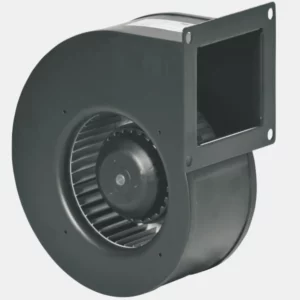What is the difference between a double inlet centrifugal fan and a single inlet centrifugal fan
The main difference between a double inlet centrifugal fan and a single inlet centrifugal fan lies in the number of inlets through which air enters the fan.
- Single Inlet Centrifugal Fan: As the name suggests, a single inlet centrifugal fan has only one inlet for air to enter the fan housing. The air is drawn in through this single inlet and directed towards the rotating impeller. The impeller then accelerates the air and directs it towards the fan’s outlet. Single inlet centrifugal fans are commonly used in various applications, including HVAC systems, industrial ventilation, and air handling units.
- Double Inlet Centrifugal Fan: A double inlet centrifugal fan, on the other hand, has two inlets for air to enter the fan housing. These inlets are symmetrically positioned on either side of the fan housing. Air is drawn in through both inlets and directed towards the impeller. The impeller accelerates the air, and it is then discharged through the fan’s outlet. Double inlet centrifugal fans are often used in applications that require higher airflow and greater static pressure, such as large-scale HVAC systems, industrial processes, and air pollution control systems.
Here are key advantages of double inlet centrifugal fans over single inlet centrifugal fans include:
- Higher Performance: Double inlet fans can generally deliver higher airflow and static pressure compared to single inlet fans of the same size. The dual inlet design allows for more efficient air intake and better utilization of the impeller’s capabilities.
- Balanced Airflow: The symmetric design of double inlet fans helps ensure balanced airflow, reducing vibration and noise levels. This can be particularly beneficial in applications where smooth and consistent airflow is required.
- Larger Size Range: Double inlet centrifugal fans are available in larger sizes and can handle higher volumes of air compared to single inlet fans. This makes them suitable for applications that require higher airflow rates and are commonly used in larger systems or industrial settings.
- Enhanced Efficiency: The design of double inlet fans, with two inlets and a larger impeller, can result in improved efficiency and performance characteristics, particularly at higher airflow rates.
It’s worth noting that the selection between a single inlet centrifugal fan and a double inlet centrifugal fan depends on factors such as the specific application requirements, system design, available space, and airflow demands.
Here is some additional information about double inlet centrifugal fans and single inlet centrifugal fans:
- Impeller Design: In both types of centrifugal fans, the impeller plays a crucial role in accelerating and directing the airflow. In a single inlet fan, the impeller is typically located on one side of the fan housing, while in a double inlet fan, the impeller is centrally positioned between the two inlets.
- Airflow Characteristics: Single inlet centrifugal fans tend to have a more radial airflow pattern, meaning the air enters the impeller in a primarily radial direction and is discharged perpendicular to the impeller’s axis. Double inlet centrifugal fans, on the other hand, generate a more axial or tangential airflow pattern due to the symmetric air intake from both sides.
- Performance Efficiency: Double inlet centrifugal fans generally offer higher efficiency compared to single inlet fans. The dual inlet design allows for better utilization of the impeller, resulting in improved performance characteristics such as higher airflow rates and enhanced static pressure capabilities.
- Size and Capacity: Double inlet centrifugal fans are commonly available in larger sizes and can handle higher volumes of air compared to single inlet fans. This makes them suitable for applications that require high airflow rates or where larger air circulation is necessary, such as large industrial ventilation systems or air handling units for large buildings.
- Noise and Vibration: The symmetrical design of double inlet fans often leads to better balance and reduced vibration levels compared to single inlet fans. This can result in quieter operation and increased durability.
- Application Considerations: Single inlet centrifugal fans are commonly used in a wide range of applications, including HVAC systems, air purifiers, and small-scale ventilation systems. They are well-suited for applications that require moderate airflow and static pressure. Double inlet centrifugal fans are typically employed in larger-scale applications, such as commercial or industrial HVAC systems, data centers, and industrial processes that demand higher airflow rates and greater static pressure capabilities.
When selecting between a double inlet centrifugal fan and a single inlet centrifugal fan, it’s important to consider factors such as the required airflow and pressure, available space, noise considerations, and overall system requirements. Consulting with an expert in the field can help in determining the most suitable fan type for a specific application.


Comments are closed.